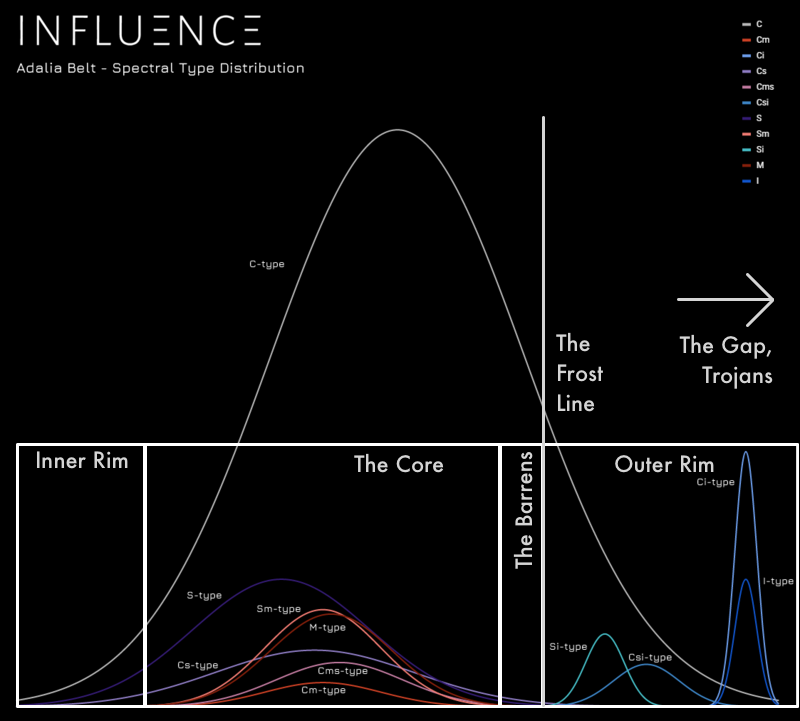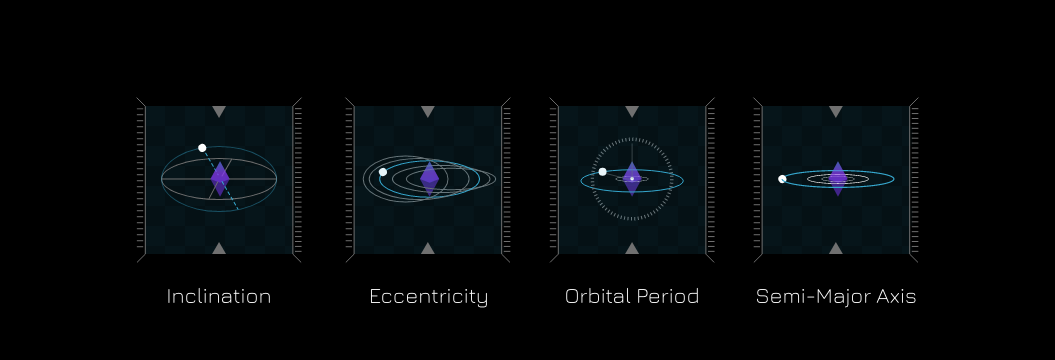The ABCD
Adalian Belt Cartographic Definitions
The Six Cardinal Directions
Spinward
Prograde; in the direction of orbit; counter-clockwise when viewed dorsally.
Antispinward
Retrograde, in the opposite direction of orbit; clockwise when viewed dorsally.
Inward
Toward the star Adalia.
Outward
Away from the star Adalia.
Dorsal
Above the orbital plane while spinward is counter-clockwise.
Ventral
Below the orbital plane while spinward is counter-clockwise.

The Adalia System
The Adalia star system is compromised of the star Adalia, five planets, and an asteroid belt.
Adalia
Adalia is both the name of the star Adalia and also the name of the whole Adalia star system. The humans living in the asteroid belt of Adalia are known as Adalians.
The Star Adalia
Also known as “Adalia Star”, “the star”, or somewhat inaccurately as “the sun”, Adalia is a main sequence star slightly smaller than Sol (the Earth’s Sun).
The Planets
Upon Arrival, the five planets were designated as A, B, C, D, and E by order of distance from the star Adalia. They were subsequently given names by the Coastin Cartographic Society during the First Coastin Convention.
Aion
Aion (or A) is a small, hot, rocky planet orbiting closest to the star. It is slightly smaller, faster, and closer to the star when compared to Mercury. Aion completes an orbit roughly every two Adalian months, or slightly less than half an orbit each month. For this reason, an “Aion” is a somewhat unofficial term for an Adalian month. Aion is named for the Greek deity representing endless, cyclical time.
Bia
Bia (or B) is a rocky planet with a thin atmosphere and both land and seas, although it is far too hot for liquid water, so the sea is made of something else. It is slightly larger than Mercury, but orbiting closer to where Venus orbits in the solar system. Initially it was hoped the Bia could be settled by the Arvad, but the first planetary scans quickly revealed that this would be impossible, forcing the settlement of the asteroid belt between Bia and Chronos instead. Bia is named for the Greek deity representing force, anger, and raw energy.
Chronos
Chronos (or C) is a gas giant roughly the size of Jupiter, although orbiting somewhat closer to its star. The current position of Chronos in it’s orbit is used as a landmark by the Coastin Cartographic Society to determine relative positions in the belt. Chronos is also the anchor for two Trojan clusters co-orbiting with it at Lagrange points L4 and L5. The largest moon of Chronos is Ananke. Chronos is named for the Greek deity representing measured time, and Ananke is named for the Greek deity of necessity, and consort of Chronos.
Dysis
Dysis (or D) is a gas giant, smaller than Chronos but still quite large. The confluence of Chronos and Dysis is regarded culturally as the "time of sunset and darkness", and an occasion to celebrate with scary stories and lighthearted spooky fun. It is named for the Greek deity representing the sunset.
Eos
Eos (or E) is a gas giant, and the fifth and final known planet of the Adalia system. It is named for the Greek deity representing the dawn.
The Belt
The Adalia System has a large asteroid belt between the orbits of Bia and Chronos (and extending slightly beyond the orbit of Chronos, in the case of the Trojan Groups).
Made up of two overall areas, the Mainbelt and the two Trojan Clusters beyond.
The Core (Within the Orbit of Bia)
The collective term for the Star Adalia and the inner two planets, beyond the inner edge of the Belt.
The Inner Rim (307-514d OP)
The part of the Mainbelt closest to Adalia Star and the orbit of Bia. Comprised of only C-, S-, and CS-type asteroids. The part of the belt orbiting the fastest, as much as nine times faster than the Trojans.
The Midbelt (515-1244d OP)
The middle of the Mainbelt, extending from the innermost Metallic asteroids out to the Frost Line. Includes Adalia Prime. Adds the M-types and Metal Mixes (M-, CM-, SM-, and CMS-types) to the C-, S-, and CS-types.
The Metal Line (1244d OP)
The point past which Metallic and Metal Mixes no longer appear. Stony Mixes do still appear, and can replace some of the missing resources of the Metallic types.
The Barrens (1245-1378d OP)
A band on the outer edge of the Midbelt from the last CMS at 1244d OP to the first SI at 1379d OP that is almost entirely C-types with a just a few S and CS-types.
The Frost Line (1379d OP)
The point past which Icy and Icy Mixes (I-, SI-, and CIS-types) begin to appear.
Outer Belt (1379-1829d OP)
The outer regions of the Mainbelt, from the Frost Line to The Stone Line. Comprised of Stony-Icy Mixes (SI- and CIS-types).
The Stone Line (1829d OP)
The point past which Stony Mixes no longer appear. Only I-, Ci-, and C-types exist past this point.
The Outer Rim (1830-1981d OP)
The farthest section of the Mainbelt, from the Stone Line to The Gap. Comprised entirely of I-, CI-, and C-types, like the Trojans beyond.
The Gap (1982-2825d OP)
An area from the orbit of Coastin at 1981d OP out to the Trojans where there are no asteroids.
The Trojans (2826d OP)
The two Trojan Groups orbit at the L4 and L5 Lagrange points of Chronos, just ahead and behind the gas giant. Called the Leading and Trailing (or Greater and Lesser, respectively) Trojans, they move as a group and all have the same OP as Chronos itself. Comprised of only C-, I-, and CI-types, like the The Outer Rim. Chronos and its moons are broadly included within this area, but are strictly off limits due to the dangerous radiation from Chronos itself.
The Strand (Beyond the Orbit of Chronos and the Trojans)
The collective term for anything beyond the outer reaches of the Belt. Includes the outer two planets and anything else out to the "adaliapause", where the Interstellar Void begins.

Orbital Mechanics
Orbital Shape
Inclination
The inclination is measured in degrees or radians and identifies the “tilt” of your orbit in relation to the Adalia System's orbital plane.
Highly inclined asteroids will spend a quarter of their orbits well above the orbital plane, and a quarter equally far below it. This means you will need to factor in additional diagonal travel distance for fully half of their orbits, making them more remote and difficult to reach. Lower amounts of inclination are generally preferred.
Eccentricity
Eccentricity measures how far from perfectly round your orbit is. 0.0 is perfectly round, and the more oval-shaped orbits have higher Eccentricity. Distance from Adalia star and orbital speed varies throughout the orbit, but the averages will be your Semi-major Axis and Orbital Period, respectively.
More eccentric orbits will vary more wildly in distance from Adalia Star and in their orbital speed, causing them to have more variety in the number and type of asteroids they will pass near to. This could be desirable, depending on specific strategies, but asteroids with lower eccentricities will be more predictable and easier to plan travel to and from.
Orbital Distance
Orbital Period
The orbital period is the amount of time it takes to complete one full orbit of the star Adalia. The orbital period determines which other asteroids are co-orbital (identical orbital period) and resonant (even multiples of the orbital period). Orbital periods of 1981 days and less are considered part of the Mainbelt, while Trojans are all co-orbital with each other at 2826 days OP.
Asteroids with similar Orbital Periods will tend to stay about the same distance from each other, whether that means they stay close or on opposite sides of the belt at all times. Asteroids with different Orbital Periods will drift away from each other fairly quickly, regardless of how close they are to each other at the moment.
Semi-major Axis
The semi-major Axis is the average of your asteroid’s closest approach to Adalia Star and its furthest distance from Adalia Star, and is measured in Astronomical Units (i.e. the distance from Earth to the Sun in the Sol System).
The Semi-major Axis is a measure of distance, but can easily be converted into the Orbital Period, which is a measure of time. The community generally favours using the OP over the SMA.

Special thank you to the Coastin Cartographic Society, ProfessorSabre, Adalia.info, and the Influence Wiki.
